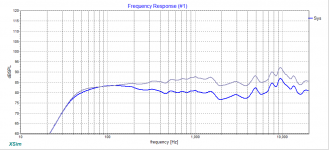Just so.
Personally I wouldn't expect vast differences in the measured response characteristic unless the spider (in particular) has yet to come into the intended operating window. Unfortunately with long-throw wideband drive units it can take longer to do this than some others. With a conventional midbass, woofer et al, you can usually get the spider broken in within an hour or so by using a progressive programme of LF test tones below Fs -say, 10 minutes of each with the driver just below the limit of travel. This isn't realistic with thin alloy cone wideband drivers like the 10.3, Eikona etc. though -they're not meant to be treated like woofers. So it can take a bit longer to get the mechanical components into the intended spec.
Be that as it may, while suffering my usual nightly insomnia I had a few moments, so out of interest, I converted my own saved FR & impedance graphs (all I had left) to frd & zma files, and had a quick look at them in XSim, since it was convenient & the limited data didn't really justify anything else. Please note: everything that follows is assuming my own data, and I am not disputing anybody else's measurements, taken with different units, different equipment, and in different conditions where it is quite possible other factors are coming into play.
Purely based on that, the attached shows the quasi-anechoic measures I took in grey, and with a 3.9mH, 15ohm LR parallel in blue. A bit much for me, with the aforementioned caveats. As a generally applicable point though, the 1.13ohm DCR of the inductor mentioned will alter the box alignment somewhat by raising the driver Q -I'd recommend a lower DCR for this role if possible, unless you happen to like the effect of course. Assuming the flattest possible quasi-anechoic response is desired out to about 1.5KHz (which personally I doubt is likely to be the most effective solution in many practical situations) then, again based purely on my data, I'd prefer something like an 0.82mH, 22uF, 3.9ohm parallel notch, which should still see a bit of damping for the bass alignment below the mass-corner frequency. YMMV as always -we all do what works best for us. That's the object of DIY after all.
Personally I wouldn't expect vast differences in the measured response characteristic unless the spider (in particular) has yet to come into the intended operating window. Unfortunately with long-throw wideband drive units it can take longer to do this than some others. With a conventional midbass, woofer et al, you can usually get the spider broken in within an hour or so by using a progressive programme of LF test tones below Fs -say, 10 minutes of each with the driver just below the limit of travel. This isn't realistic with thin alloy cone wideband drivers like the 10.3, Eikona etc. though -they're not meant to be treated like woofers. So it can take a bit longer to get the mechanical components into the intended spec.
Be that as it may, while suffering my usual nightly insomnia I had a few moments, so out of interest, I converted my own saved FR & impedance graphs (all I had left) to frd & zma files, and had a quick look at them in XSim, since it was convenient & the limited data didn't really justify anything else. Please note: everything that follows is assuming my own data, and I am not disputing anybody else's measurements, taken with different units, different equipment, and in different conditions where it is quite possible other factors are coming into play.
Purely based on that, the attached shows the quasi-anechoic measures I took in grey, and with a 3.9mH, 15ohm LR parallel in blue. A bit much for me, with the aforementioned caveats. As a generally applicable point though, the 1.13ohm DCR of the inductor mentioned will alter the box alignment somewhat by raising the driver Q -I'd recommend a lower DCR for this role if possible, unless you happen to like the effect of course. Assuming the flattest possible quasi-anechoic response is desired out to about 1.5KHz (which personally I doubt is likely to be the most effective solution in many practical situations) then, again based purely on my data, I'd prefer something like an 0.82mH, 22uF, 3.9ohm parallel notch, which should still see a bit of damping for the bass alignment below the mass-corner frequency. YMMV as always -we all do what works best for us. That's the object of DIY after all.
Attachments
Last edited:
Hi zman01 - many thanks for your kind welcome!!
@Scottmoose - many thanks for your comment and illustrating the impact of my filter. I did investigate a few notches (RLCs) and the values you suggest are for a notch which is a bit higher in frequency. At least with my driver units, the few RLCs I investigated did not quite make me happy. As your measurement data look vastly different (notably in the bass region), I'm still tempted to say that my units might be simply a bit different. Of course I'm sorry to hear from your insomnia - sleepless nights aren't fun so I hope you recover soon!
@Scottmoose - many thanks for your comment and illustrating the impact of my filter. I did investigate a few notches (RLCs) and the values you suggest are for a notch which is a bit higher in frequency. At least with my driver units, the few RLCs I investigated did not quite make me happy. As your measurement data look vastly different (notably in the bass region), I'm still tempted to say that my units might be simply a bit different. Of course I'm sorry to hear from your insomnia - sleepless nights aren't fun so I hope you recover soon!
- Status
- This old topic is closed. If you want to reopen this topic, contact a moderator using the "Report Post" button.
